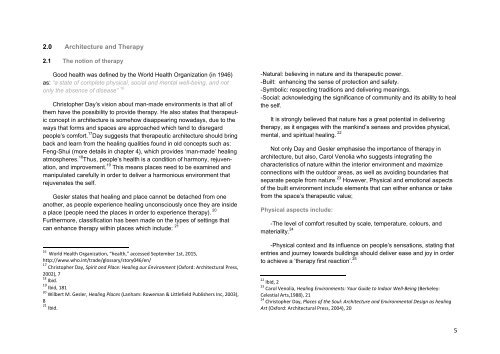Noor Abid_2016-02-19
You also want an ePaper? Increase the reach of your titles
YUMPU automatically turns print PDFs into web optimized ePapers that Google loves.
2.0 Architecture and Therapy<br />
2.1 The notion of therapy<br />
-Natural: believing in nature and its therapeutic power.<br />
Good health was defined by the World Health Organization (in <strong>19</strong>46)<br />
21 Ibid. Art (Oxford: Architectural Press, 2004), 20<br />
as: “a state of complete physical, social and mental well-being, and not<br />
only the absence of disease” 16<br />
-Built: enhancing the sense of protection and safety.<br />
-Symbolic: respecting traditions and delivering meanings.<br />
-Social: acknowledging the significance of community and its ability to heal<br />
Christopher Day’s vision about man-made environments is that all of the self.<br />
them have the possibility to provide therapy. He also states that therapeutic<br />
concept in architecture is somehow disappearing nowadays, due to the<br />
ways that forms and spaces are approached which tend to disregard<br />
people’s comfort. 17 Day suggests that therapeutic architecture should bring<br />
It is strongly believed that nature has a great potential in delivering<br />
therapy, as it engages with the mankind’s senses and provides physical,<br />
mental, and spiritual healing. 22<br />
back and learn from the healing qualities found in old concepts such as:<br />
Feng-Shui (more details in chapter 4), which provides ‘man-made’ healing<br />
Not only Day and Gesler emphasise the importance of therapy in<br />
atmospheres. 18 Thus, people’s health is a condition of harmony, rejuvenarchitecture,<br />
but also, Carol Venolia who suggests integrating the<br />
ation, and improvement. <strong>19</strong> This means places need to be examined and<br />
characteristics of nature within the interior environment and maximize<br />
manipulated carefully in order to deliver a harmonious environment that<br />
connections with the outdoor areas, as well as avoiding boundaries that<br />
rejuvenates the self.<br />
separate people from nature. 23 However, Physical and emotional aspects<br />
of the built environment include elements that can either enhance or take<br />
Gesler states that healing and place cannot be detached from one<br />
another, as people experience healing unconsciously once they are inside<br />
a place (people need the places in order to experience therapy). 20<br />
from the space’s therapeutic value;<br />
Physical aspects include:<br />
Furthermore, classification has been made on the types of settings that<br />
can enhance therapy within places which include: 21<br />
-The level of comfort resulted by scale, temperature, colours, and<br />
materiality. 24<br />
-Physical context and its influence on people’s sensations, stating that<br />
16 World Health Organization, “health,” accessed September 1st, 2015,<br />
entries and journey towards buildings should deliver ease and joy in order<br />
http://www.who.int/trade/glossary/story046/en/<br />
17 Christopher Day, Spirit and Place: Healing our Environment (Oxford: Architectural Press,<br />
to achieve a ‘therapy first reaction’. 25<br />
20<strong>02</strong>), 7<br />
18 Ibid.<br />
Ibid, 2<br />
<strong>19</strong> Ibid, 181<br />
Carol Venolia, Healing Environments: Your Guide to Indoor Well-Being (Berkeley:<br />
20 Wilbert M. Gesler, Healing Places (Lanham: Roweman & Littlefield Publishers Inc, 2003), Celestial Arts,<strong>19</strong>88), 21<br />
8<br />
24 Christopher Day, Places of the Soul: Architecture and Environmental Design as healing<br />
5



